Before aluminum enclosures were an option, backflow preventers were often covered with some type of box or building. Construction was conventional building materials like block, brick, wood, roofing material and paint. As is often the case, necessity became the mother of invention and the founders of Safe-T-Cover™ knew there had to be a better way to cover a backflow preventer. The aluminum backflow enclosure was born.
We recently worked on a project that called for a block building in the design. The building would cover the fire and domestic lines, including the water meter for a large commercial development. The enclosure was approximately 9 feet wide x 20 feet long x 7 feet tall.
Answers To Common Backflow Enclosure Questions
The contractor on the project called us to look for another possible solution. The first question was the assembly. We explained that the backflow cover would be shipped to the job site in cartons and easily installed by two workers in just a few hours. The contractor said this makes the job easier compared to obtaining prices from several different trades and then coordinating the work. The contractor felt the enclosure could be ordered and installed more quickly than constructing the block building.
Next, the contractor wanted to know about lead time. A custom enclosure should not require more than two to three weeks of lead time. The contractor was surprised to learn a custom enclosure could be shipped to the job site so quickly and would meet the schedule requirements for the project.
Lastly, the contractor asked about a ballpark price to see if this was beneficial for the owner. Within an hour, the contractor had a quote. The contractor responded and said they would contact us once they had bids compiled from the subcontractor. Within a few days, the contractor called to indicate the aluminum backflow enclosure would save the owner approximately $10,000 on the project.
The contractor proposed the backflow enclosure to the design team for review and approval. Upon receiving this approval, the cover was proposed to the owner and was approved.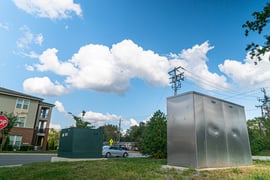
Aluminum backflow enclosures offer a better solution than conventional building methods. If the water jurisdiction requires a building to cover the backflow preventer, here’s a possible solution that can save time and money on the project. Contact us to discuss your next project.
For a quick review of the basics and pros and cons of a building, take a look at these notes below.
What Brick And Block Buildings May Offer
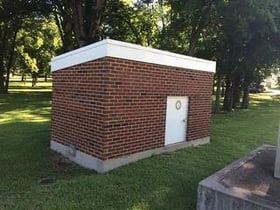 Protection: A brick and block building with locking mechanism provides protection from thieves, vandals and accidents. Heaters provide protection from freezing.
Protection: A brick and block building with locking mechanism provides protection from thieves, vandals and accidents. Heaters provide protection from freezing.
Sizes: customized to the dimensions of the device and its clearances
Materials: brick, painted cement block, wood, shingles, paint
Important to Note: These enclosures may not comply with the intentions of ASSE 1060 standards. The materials used are not on the approved list provided by the ASSE. This means they are not subjected to the same rigorous testing as aluminum, fiberglass or steel backflow enclosures. Most municipalities require or recommend all enclosures for backflow preventers be ASSE 1060-certified. If freeze protection is important, a design engineer would need to certify that the backflow device would not freeze during winter conditions. ASSE 1060 drain requirements must also be considered.
What Brick And Block Buildings May Lack
A brick and block enclosure performs the same function as an aluminum enclosure; namely protection from vandalism, protection from theelements, and if necessary protection from freezing by using some type of heating system.
A brick enclosure can be built to match the look of its surroundings. Some look rather attractive and could be mistaken for garden sheds or storage houses, which are a commonly accepted site in our country. If someone wanted a customized brick, block, or wooden backflow shelter, they could choose the materials used to build it. The problem with that sentiment is that most of the time, the commercial or industrial building owner is not involved in the choosing and designing of a backflow enclosure. If the people designing the system don't really care how the end result looks, it can be pretty unsightly as can be seen in some of these pictures.
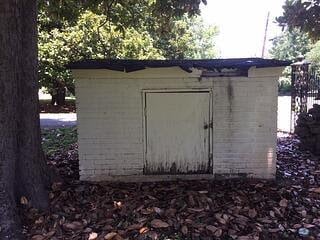
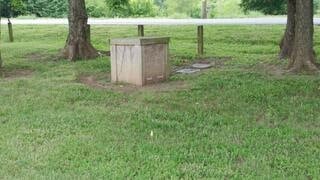
The Benefits Of A Backflow Enclosure
Getting your backflow preventer above ground is what’s most important. But installing it inside an aluminum backflow enclosure will provide you many benefits compared to a building. The benefits include:
- ASSE 1060 – Buildings we have seen don’t include the ability to drain a flooding RPZ backflow assembly. As more and more RPZs are required, the building must have a drain or water can built inside and not only create a cross-connection but the water pressure can cause the building to break apart. ASSE 1060 aluminum backflow covers have drains that allow any flooding water to escape.
- Access – take a look at these pictures of the brick and block enclosures and think about the size of the doors. The access is very limited if the backflow device needs to be removed or even just repaired. Aluminum enclosures have large, removable access panels and some manufacturers allow the roof to be removed if necessary for when the equipment needs to be lifted out.
- Design Speed – Amazon is training buyers to expect things the next day. This is spreading into other areas of our lives and is also the case regarding design and construction. Building owners expect things to be done faster and faster. With the aluminum backflow enclosure, the designer spends a very small amount of time selecting the appropriate enclosure compared to the time required to design a brick and block building. In addition to a listing of all their standard enclosures, some manufacturers offer calculators, like our backflow enclosure sizing guide, to help speed up the design process.
- Assembly speed – speed on the construction site is also demanding. The brick and block building will take several days to build and would require the coordination of several different subcontractors including a brick mason, a roofer and a painter. The aluminum enclosure can be installed by two men and it typically takes less than a couple of hours. Watch this video of two of our workers assembling one.
- Life-cycle cost – an aluminum enclosure will last for decades and requires no ongoing maintenance. On the other hand, a brick and block cover, especially one that contains wood, might not last as long. If the brick and block enclosure is painted, maintenance will be required every 5-10 years to keep the wood from rotting and to maintain the look of the enclosure.
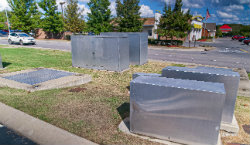
Aluminum backflow enclosures offer a better solution than conventional building methods. If the water jurisdiction requires a building to cover the backflow preventer, here’s a possible solution that can save time and money on the project. Contact us to discuss your next project.
You can find out more about backflow prevention assemblies and where they should be installed by looking through our guide “Trends in Backflow Preventer Installation.” It’s a great resource for anyone responsible for commercial water supply and infrastructure.




